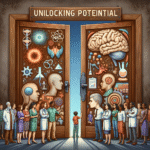Introduction
In a world dominated by screens, notifications, and endless distractions, the art of genuine human connection seems to be fading. The connection we once shared through eye contact and heartfelt conversations has been replaced by likes, shares, and emojis. In this chaotic environment, compassion emerges as a powerful antidote.
Compassion is often perceived as an inherent trait, something some possess while others lack. However, compassion can be cultivated and developed into a vital skill—a skill that can bridge the gap created by our digital lives. This journey leads us to the focus of this article: Compassion as a Skill: Learning to Connect in a Distracted World. By harnessing compassion, we can not only enrich our lives but also foster deeper connections, both personally and professionally.
Understanding Compassion as a Skill
What is Compassion?
Compassion goes beyond mere empathy; it involves recognizing another’s suffering and taking action to alleviate it. This may manifest through active listening, offering help, or even just being present.
The Importance of Learning Compassion as a Skill
- Enhanced Relationships: Compassion strengthens relationships, promoting trust and mutual respect.
- Improved Mental Health: Studies link compassionate behavior with reduced anxiety and depression.
- Effective Leadership: Compassionate leaders inspire and motivate teams, fostering a culture of collaboration.
The Science Behind Compassion
Understanding the neurological basis of compassion highlights its importance in our lives. Research shows that compassionate activities activate brain regions related to altruism, reinforcing positive social behaviors.
Case Study: Compassion Training in Healthcare
A notable example can be seen in healthcare settings where staff undergo compassion training programs. One striking study involved a group of nurses who participated in a workshop that emphasized empathetic communication. Before the program, patient satisfaction scores were woefully low. Post-training evaluations showed a 40% increase in patient satisfaction, demonstrating the power of compassion in creating better healthcare experiences.
| Metric | Before Training | After Training |
|---|---|---|
| Patient Satisfaction Score | 65% | 90% |
| Staff Retention Rate | 70% | 85% |
Barriers to Compassion in a Disconnected World
Despite its importance, many obstacles hinder our ability to practice compassion:
- Digital Distractions: Constant notifications divert our attention and diminish face-to-face interactions.
- Judgment and Bias: Preconceived notions about others can cloud our ability to empathize.
- Stress and Burnout: Personal stressors can lead to emotional fatigue, reducing our capacity for compassionate behavior.
Cultivating Compassion: Practical Strategies
To fully embrace Compassion as a Skill: Learning to Connect in a Distracted World, we must practice intentional steps to cultivate it.
1. Mindfulness
Mindfulness practices can sharpen our awareness of both our feelings and the feelings of others. Try a simple mindfulness meditation:
- Sit in a comfortable position and close your eyes.
- Take a deep breath in, focusing on your breath.
- Visualize a person who is suffering and send them your compassion through positive thoughts or mantras.
2. Active Listening
Active listening entails fully engaging with the speaker. This can be achieved through:
- Maintaining eye contact.
- Nodding to show understanding.
- Avoiding the urge to interrupt, allowing the other person to express themselves fully.
3. Volunteering
Volunteering can provide firsthand experiences of compassion in action. It encourages us to step into others’ shoes and see the world from their perspective.
4. Compassionate Communication
Using empathetic language can enhance your communication. This includes:
- Using "I" statements (e.g., "I feel…" instead of "You never…").
- Acknowledging the other person’s feelings.
Case Study: Compassion in Education
A recent study in schools implemented a comprehensive compassion curriculum, focusing on social-emotional learning. This initiative led to a substantial decrease in bullying incidents and a notable improvement in students’ overall emotional well-being. The program’s design included role-playing scenarios that fostered understanding among peers.
| Metric | Before Program | After Program |
|---|---|---|
| Bullying Incidents | 30 | 10 |
| Emotional Well-being Score | 50% | 80% |
The Role of Technology in Fostering Compassion
Technological advances can sometimes facilitate compassion, even amidst distractions.
The Use of Apps
Several apps designed to foster connection and empathy hold promise. For instance:
- Calm introduces mindfulness techniques.
- 7 Cups connects users to online listeners offering support.
The Ripple Effect of Compassion
Compassion doesn’t just benefit the giver and receiver; it creates a ripple effect that spreads throughout communities. A simple act of kindness can inspire others to do the same, leading to a cycle of compassion that propagates within larger networks.
Conclusion
Embracing Compassion as a Skill: Learning to Connect in a Distracted World is not only vital for individual well-being but for the collective health of our communities. As we develop this skill, we break down barriers, create deeper connections, and foster a more caring society.
Reflections and Actionable Insights
- Start Small: Begin by practicing compassion in everyday interactions. A smile or a kind word can be the first step.
- Reflect: Take time daily to consider how your actions can impact others positively.
- Engage: Involve yourself in community initiatives focused on compassion and kindness.
FAQs
1. Can compassion be taught?
Yes, compassion can be cultivated through training and intentional practice. Workshops and programs aimed at promoting compassionate behaviors have shown significant success.
2. How can I practice compassion in a professional setting?
Active listening, fostering inclusive dialogues, and offering support to colleagues in need are effective ways to practice compassion at work.
3. What are some quick ways to connect with others?
Simple gestures like maintaining eye contact, genuine smiles, and asking open-ended questions can create space for deeper connections.
4. Why is compassion important in leadership?
Compassionate leaders create more engaged teams, fuel motivation, and foster open communication, leading to enhanced productivity.
5. What role does empathy play in compassion?
Empathy is the foundation of compassion; understanding someone’s experiences allows us to respond compassionately and supportively.
In this distracted world, we must prioritize compassion and foster meaningful connections, paving the way for a more connected and supportive society. Let’s harness the skill of compassion to navigate the chaos around us, ensuring that we remain genuinely connected to one another.

















